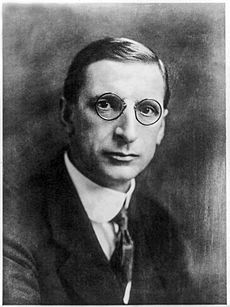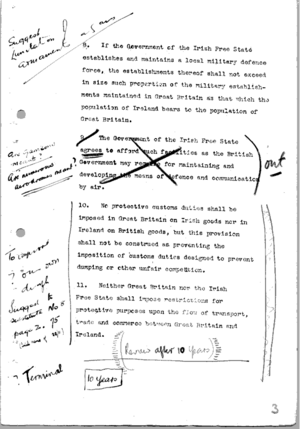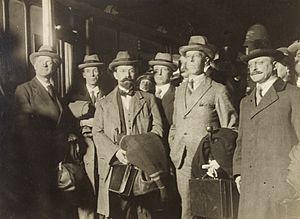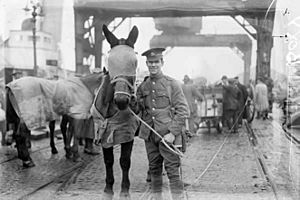Anglo-Irish Treaty facts for kids
| Articles of Agreement for a Treaty Between Great Britain and Ireland | |
|---|---|

Signature page
|
|
| Signed | 6 December 1921 |
| Location | 10 Downing Street, London |
| Effective | 31 March 1922, fully implemented on 6 December 1922 |
| Condition | Creation of the Irish Free State, later Ireland |
| Signatories | |
| Languages | English |
| Text of the Treaty | |
The Anglo-Irish Treaty (Irish: An Conradh Angla-Éireannach) was an important agreement signed in 1921. It is often called The Treaty in Ireland. This agreement was made between the government of the United Kingdom and representatives from the Irish Republic. It officially ended the Irish War of Independence.
The Treaty led to the creation of the Irish Free State within a year. This new state would be a self-governing country, similar to Canada, within the British Empire. The Treaty also gave Northern Ireland a choice. Northern Ireland, which was created in 1920, could choose to stay out of the new Irish Free State. The Parliament of Northern Ireland decided to do this.
The agreement was signed in London on 6 December 1921. Key people who signed it included David Lloyd George, the British Prime Minister, and Irish leaders like Michael Collins and Arthur Griffith. The Irish representatives had special authority to sign the treaty. This meant they could make decisions without asking their leaders first. However, the British government did not officially recognize Ireland as a fully independent country at that time.
The Treaty needed to be approved by both the British Parliament and a meeting of Irish elected members. In Ireland, the Second Dáil (the Irish Parliament) debated and then approved the Treaty. Even though it was approved, the decision caused a big split among Irish leaders. This disagreement led to the Irish Civil War, which was won by those who supported the Treaty. The Irish Free State officially began on 6 December 1922.
Contents
What Was in the Treaty?
The Anglo-Irish Treaty had several main points:
- The British army would leave most of Ireland.
- Ireland would become a self-governing country, called a dominion, within the British Empire. Other dominions included Australia, Canada, New Zealand, and South Africa.
- Like other dominions, the King of Britain would be the Head of State for the Irish Free State. He would be represented by a Governor General.
- Members of the new Irish Parliament had to take an Oath of Allegiance. This oath was to the Irish Free State, and also promised loyalty to King George V.
- Northern Ireland could choose to leave the Irish Free State within one month of the Treaty starting.
- If Northern Ireland left, a special Boundary Commission would be set up. Its job was to draw the exact border between the Irish Free State and Northern Ireland.
- Britain would keep control of a few ports, called Treaty Ports, for its navy. This was for their own security.
- The Irish Free State would take on a fair share of the United Kingdom's debt from before the Treaty was signed.
- The Treaty would be more important than Irish laws. If there was a disagreement between the Treaty and the new 1922 Irish Constitution, the Treaty would win.
Who Negotiated the Treaty?
Important people from both sides worked on the Treaty:
| Portrait | Name | Role |
|---|---|---|
 |
David Lloyd George (leader of the British team) | Prime Minister |
 |
Lord Birkenhead | Lord Chancellor (a senior legal role) |
 |
Austen Chamberlain |
|
 |
Winston Churchill | Secretary of State for the Colonies (in charge of British colonies) |
 |
Sir Laming Worthington-Evans, Bt | Secretary of State for War (in charge of the army) |
 |
Sir Gordon Hewart | Attorney General (chief legal advisor) |
 |
Sir Hamar Greenwood | Chief Secretary for Ireland |
| Portrait | Name | Role |
|---|---|---|
 |
Arthur Griffith (leader of the Irish team) | Secretary of State for Foreign Affairs |
 |
Michael Collins | Secretary of State for Finance |
 |
Robert Barton | Secretary of State for Economic Affairs |
 |
Eamonn Duggan | |
 |
George Gavan Duffy |
Secretaries who helped with the negotiations included:
- For the British: Thomas Jones and Lionel George Curtis.
- For the Irish: Erskine Childers, Fionán Lynch, Diarmuid O'Hegarty, and John Smith Chartres.
Robert Barton was the last person who signed the Treaty to pass away. He died in 1975 at 94 years old.
It's important to know that Éamon de Valera, who was the President of the Irish Republic, did not attend these talks.
How the Negotiations Happened

After a ceasefire ended the Anglo-Irish War, Irish and British leaders met several times in London. The British Prime Minister, Lloyd George, sent his first ideas for a treaty in July 1921. These ideas were quite similar to the final Treaty.
The first two weeks of talks were formal. Then, Arthur Griffith and Michael Collins asked for informal meetings. In these, only two people from each side attended. Collins and Griffith always represented Ireland. On the British side, Austen Chamberlain was always there, with another British negotiator joining him.
In late November, the Irish team went back to Dublin to talk with their cabinet. They returned to London on 3 December. Many things still needed to be agreed upon, especially the oath to the King. It was clear that a fully united, 32-county Irish Republic was not going to happen.
When they came back, Collins and Griffith worked out the final details. The British made some changes to the oath and parts about defense and trade. A boundary commission was also added to the Treaty. Collins and Griffith then convinced the other Irish negotiators to sign. The Treaty was signed very early in the morning on 6 December 1921, at 10 Downing Street.
Michael Collins later said that Lloyd George threatened the Irish delegates. He supposedly said that if they didn't sign, a "terrible and immediate war" would start again. One of the Irish negotiators, Robert Barton, remembered Lloyd George saying that those who were not for peace would be responsible for the war that would follow.
On 8 December, Éamon de Valera held a cabinet meeting to discuss the Treaty. He spoke against it. However, the cabinet voted to recommend the Treaty to the Dáil (Irish Parliament) on 14 December.
Debating the Treaty
The Treaty caused a big disagreement among Ireland's leaders. President Éamon de Valera led the group that was against the Treaty. The debates in the Dáil were very difficult. They showed the different ideas people had about Ireland's past and future.
The main argument was about Ireland's status. Many wanted a fully independent republic, not a dominion within the British Empire. The Oath of Allegiance to the King was a major sticking point. The Partition of Ireland (dividing Ireland into two parts) was also a big concern for many. Some members, especially women, wanted to continue fighting until a 32-county Irish state was formed.
The Dáil voted to approve the Treaty. However, those who disagreed refused to accept the vote. This led to the Irish Civil War.
Approval and Ratification
The Treaty needed to be approved by:
- The Parliament of the United Kingdom.
- A special meeting of the members elected to the House of Commons of Southern Ireland.
The British House of Commons approved the Treaty on 16 December 1921. The House of Lords also voted in favor on the same day.
The Dáil (Irish Parliament) approved the Treaty on 7 January 1922, after nine days of public debate. The vote was 64 to 57 in favor. However, the Dáil was not the exact group mentioned in the Treaty. So, a special "meeting" was held on 14 January 1922. This meeting formally approved the Treaty. Only pro-Treaty members and four elected unionists attended this meeting. They approved the Treaty and chose Michael Collins to lead the new provisional government.
The British Parliament then passed a law, the Irish Free State (Agreement) Act 1922, on 31 March 1922. This law officially put the Treaty into action. On 11 July 1924, the Irish Free State officially registered the Treaty with the League of Nations.
What Happened Next?
The disagreement over the Treaty led to the Irish Civil War (1922–1923). Sadly, two of the main Irish people who signed the Treaty, Arthur Griffith and Michael Collins, both died in 1922. Griffith died from heart failure, and Collins was killed in an ambush by anti-Treaty forces. W. T. Cosgrave took over their roles. Two other Irish delegates, Robert Barton and Erskine Childers, fought against the Treaty in the Civil War. Childers was executed in November 1922.
The parts of the Treaty about the King, the governor-general, and the Treaty being superior to Irish law were removed from the Irish Free State's Constitution in 1932. This happened after the British Parliament passed the Statute of Westminster. This law meant that the British Parliament could no longer make laws for dominions without their permission. So, the Irish Free State could change its own laws.
Years earlier, Michael Collins had said that the Treaty would give Ireland "the freedom to achieve freedom." Even Éamon de Valera, who opposed the Treaty, later agreed that this was true. He said that his opponents had done a "magnificent" job in gaining independence for Ireland.
The British government had wanted some form of self-rule for all of Ireland since 1914. However, they believed that giving complete independence to all of Ireland in 1921 would cause a lot of violence between Protestants (Unionists) and Catholics (Nationalists). Unionists were mainly in the north-east of Ireland. They might have rebelled against full Irish independence. So, giving dominion status to 26 counties, and letting the six northern counties stay separate, seemed like the best solution at the time.
What Ireland gained with dominion status was much more than earlier offers of self-rule. It was a big step towards Irish independence, even though it meant Northern Ireland was separated. Even de Valera's secret proposals during the Treaty debates were not very different from the final agreement. They were far from the fully independent, 32-county republic he publicly wanted.
See also
- Oath of Allegiance (Ireland)
- Anglo-Irish Treaty Dáil vote
- Irish Free State
- Irish Civil War
- Other treaties between Britain and Ireland:
- Anglo-Irish Trade Agreement (1938)
- Sunningdale Agreement (1973)
- Anglo-Irish Agreement (1985)
- Good Friday Agreement (1998)
- St Andrews Agreement (2006)





